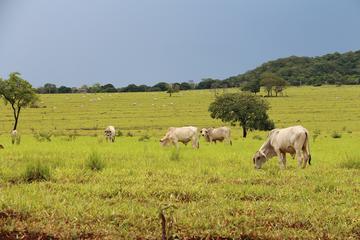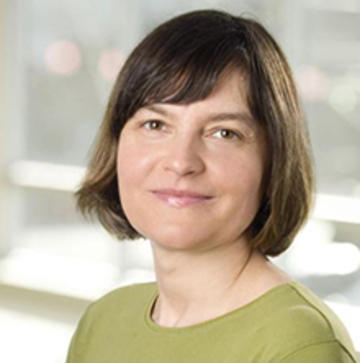There is never going to be a world where we don't have to make tough choices
An interview with Dr Monika Zurek
For Dr Monika Zurek, Leader of the Food Systems Transformation Group at the Environmental Change Institute, 'reading' different landscapes was something she learnt to do in childhood, from her parents who were both agricultural scientists. Wherever they lived, her parents were looking at landscapes and food markets to understand them through the foods being grown and sold, and what this then explained about the relationships between people and nature in different places. Such a childhood is ideal then for better understanding complex food systems, and how they work (or don't work) with and for nature and people.

After a PhD with CIMMYT and the Justus-Liebig University Giessen, in Germany, Dr Zurek worked on the Millennium Ecosystem Assessment while at the Food and Agriculture Organisation of the United Nations (FAO) in Rome, and then later for the Gates Foundation in Seattle. It was through her work at FAO that she met John Ingram, who was leading the way in food systems thinking, first through the international research collaboration GECAFS and then at the University of Oxford.
In order to understand how food ends up on our plates, we need to use systems thinking tools, Zurek explains. Food systems are complex, immensely so, and systems thinking provides a theory and a set of tools for working with that complexity without 'reducing it all to a very streamlined, linear understanding of food as a value-chain'. And systems thinking is what we need if we are to make changes to move the food system in the right direction. This means bringing different stakeholders of the system together, 'with very different perspectives and very different ideas about what the system is, what it should provide, where it should go, to have a structured conversation, because nobody sees the whole system'.
Nobody sees the whole food system

Dr Zurek is concerned with the way our global food system doesn't provide what we really need - the system claims to be efficient but is it really? We have dual challenges of hunger and obesity, both fuelled by malnutrition, but there are also environmental and social costs hidden in the system and questions of livelihoods too. 'Why is a healthy meal often more expensive than a meal at a fast-food house? That for me really shows that something is not working in the current system,' she says. Food systems tools, like the ones that the Food Systems Transformation Group have been developing over the last ten years, help us to understand the interactions within the food system, its dynamics and driving forces, and then support the development of solutions, and the interrogation of those solutions. These approaches are particularly important for creating sustainable long-term change within the food system as a whole. Monika explains this is one area she is focused on at present - considering the trade-offs we implicitly make across the people in the system, people and nature, short-term and long-term, when thinking about how we might move the food system in a direction that provides for people but also 'leaves space for nature and the rest of the species on the planet to thrive'.
How might we understand these challenges? Food systems mapping tools together with foresight methods help bring long-term perspectives and understandings of what might occur in the future, the drivers that are emerging, and the needs and wants people have both now and in the future together. Such tools allow researchers to develop, for example, a set of explanatory scenarios that can then be used to stress test different options for change. Seeing what might work (or not) in different food system futures can provide insights into policies we might instigate now to either create specific futures or adapt to things in the future. Systems tools give us the opportunity to visualise the whole system, which, as Zurek says, can look incredibly messy at first glance. But, these visual maps allow us to examine different aspects of the complex system - for example, what does the structure look like? Currently, our food system is shaped like an hourglass, with plenty of farmers and producers, a much smaller set of processors and retailers, and then many consumers. How does something like bringing in a farmers' market, where farmers can sell directly to consumers, then change the shape of the system? What does this add or remove within the wider systems? What are the unexpected outcomes? Such tools allow decision makers also to really see how food systems outcomes are related to each other, how changing one aspect of the system might then impact on another, and on other interconnected systems like energy and water.
'Systems tools help find the sweet spot between exploring and working with the interconnectedness within a system and being overwhelmed and paralysed by it'. For Dr Zurek, it is the trade-offs that we are often not very good at identifying and working with currently. 'Due to the interconnected nature of any system, there is never going to be a world where we don't have trade-offs or 'costs' associated with change. The main thing right now that bugs me is that many people taking decisions are not looking at, or are not aware of, the unintended hidden costs of the decisions'. So finding a better way to understand trade-offs and bringing them into decision making in a way that shapes incentives around the type of change we want, is important. 'It's that disconnect between people who benefit from the way the current food system works and people paying the costs that is so strong. I think in an ideal food system we would have mechanisms to identify and address these disparities much better'.
In an ideal food system, we would have mechanisms to identify and address costs and benefits much better

Can we not do better?, Zurek asks. 'Does the way we feed ourselves have to be so detrimental, both to people and planet? We can send people to the moon and soon to Mars, can we not sort out a food system that doesn't hurt us and the rest of our planet at the same time? Where are we putting our resources? The biggest worry, she says, is that we are not transitioning fast enough, and we may reach tipping points - in environmental impacts, in equity impacts - that make any way back extremely difficult and costly. One thing she has learned from her years working in global environmental assessments and in academia, is that good information is the necessary minimum to create change, but it doesn't necessarily make someone do something different. 'The question that I am most interested in is: how do you incentivise long term change in food systems that is good for people and planet?




